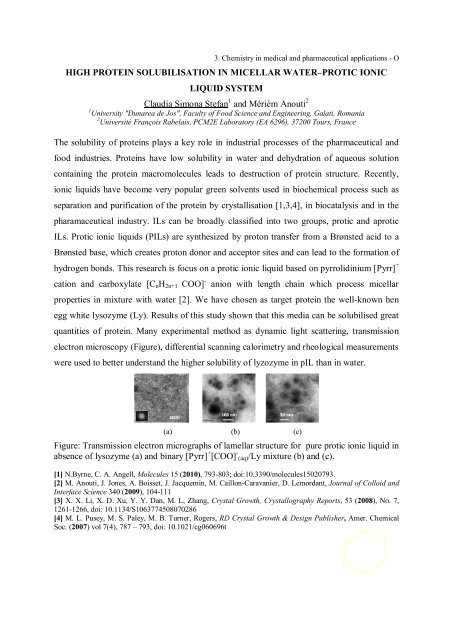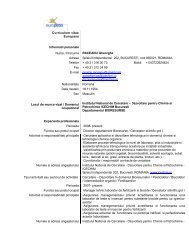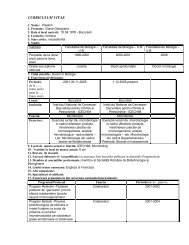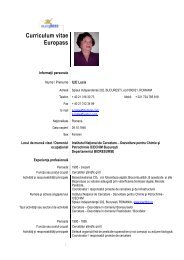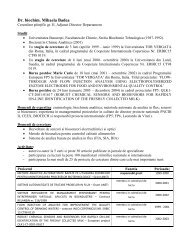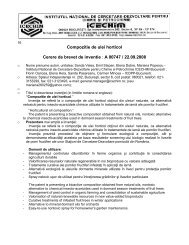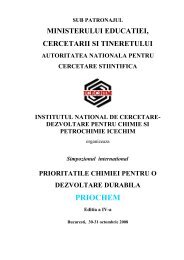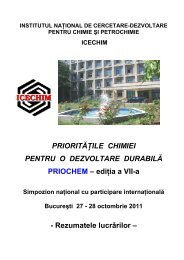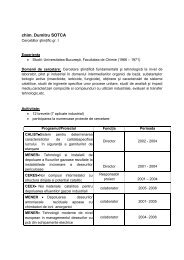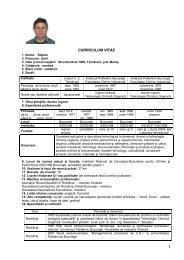INSTITUTUL NAÅ¢IONAL DE CERCETARE-DEZVOLTARE - ICECHIM
INSTITUTUL NAÅ¢IONAL DE CERCETARE-DEZVOLTARE - ICECHIM
INSTITUTUL NAÅ¢IONAL DE CERCETARE-DEZVOLTARE - ICECHIM
- No tags were found...
Create successful ePaper yourself
Turn your PDF publications into a flip-book with our unique Google optimized e-Paper software.
3. Chemistry in medical and pharmaceutical applications - OHIGH PROTEIN SOLUBILISATION IN MICELLAR WATER–PROTIC IONICLIQUID SYSTEMClaudia Simona Stefan 1 and Mérièm Anouti 21 University "Dunarea de Jos", Faculty of Food Science and Engineering, Galati, Romania2 Université François Rabelais, PCM2E Laboratory (EA 6296), 37200 Tours, FranceThe solubility of proteins plays a key role in industrial processes of the pharmaceutical andfood industries. Proteins have low solubility in water and dehydration of aqueous solutioncontaining the protein macromolecules leads to destruction of protein structure. Recently,ionic liquids have become very popular green solvents used in biochemical process such asseparation and purification of the protein by crystallisation [1,3,4], in biocatalysis and in thepharamaceutical industry. ILs can be broadly classified into two groups, protic and aproticILs. Protic ionic liquids (PILs) are synthesized by proton transfer from a Brønsted acid to aBrønsted base, which creates proton donor and acceptor sites and can lead to the formation ofhydrogen bonds. This research is focus on a protic ionic liquid based on pyrrolidinium [Pyrr] +cation and carboxylate [C n H 2n+1 COO] - anion with length chain which process micellarproperties in mixture with water [2]. We have chosen as target protein the well-known henegg white lysozyme (Ly). Results of this study shown that this media can be solubilised greatquantities of protein. Many experimental method as dynamic light scattering, transmissionelectron microscopy (Figure), differential scanning calorimetry and rheological measurementswere used to better understand the higher solubility of lyzozyme in pIL than in water.(a) (b) (c)Figure: Transmission electron micrographs of lamellar structure for pure protic ionic liquid inabsence of lysozyme (a) and binary [Pyrr] + [COO] - (aq)/Ly mixture (b) and (c).[1] N.Byrne, C. A. Angell, Molecules 15 (2010), 793-803; doi:10.3390/molecules15020793.[2] M. Anouti, J. Jones, A. Boisset, J. Jacquemin, M. Caillon-Caravanier, D. Lemordant, Journal of Colloid andInterface Science 340 (2009), 104-111[3] X. X. Li, X. D. Xu, Y. Y. Dan, M. L, Zhang, Crystal Growth, Crystallography Reports, 53 (2008), No. 7,1261-1266, doi: 10.1134/S1063774508070286[4] M. L. Pusey, M. S. Paley, M. B. Turner, Rogers, RD Crystal Growth & Design Publisher, Amer. ChemicalSoc. (2007) vol 7(4), 787 – 793, doi: 10.1021/cg060696t


